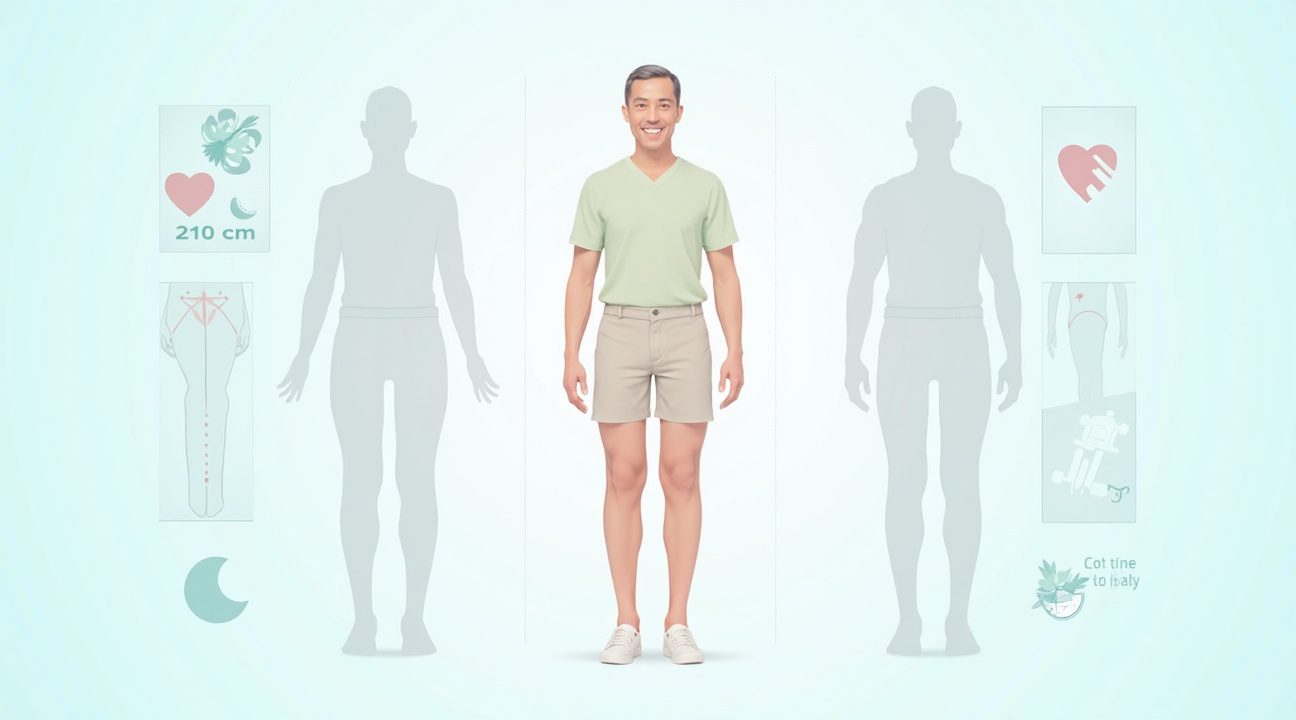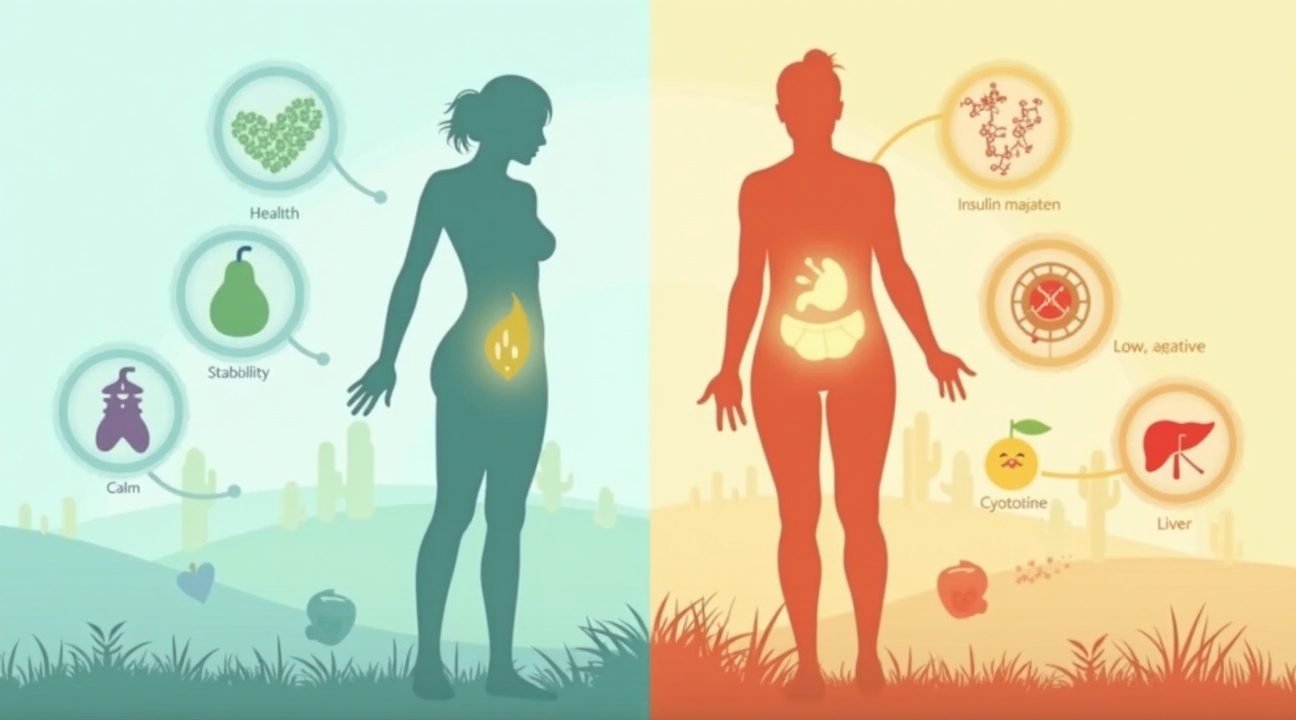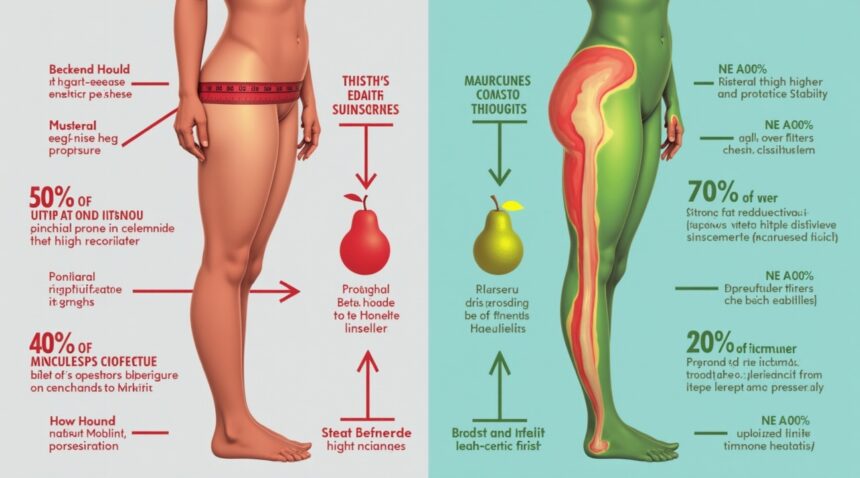Research demonstrates that larger thigh circumference serves as a powerful predictor of cardiovascular health, with studies showing individuals possessing the largest thigh measurements experience nearly 50% lower odds of developing hypertension and heart disease compared to those with smaller measurements. This protective effect stems from the metabolic benefits of thigh muscle mass and favorable fat distribution, which actively improve insulin sensitivity, regulate blood sugar levels, and reduce inflammation markers associated with chronic disease.
Key Takeaways
- Thigh circumference below 55 cm for men and 54 cm for women signals elevated cardiovascular risk and higher all-cause mortality rates
- Larger thighs reduce hypertension risk by up to 50% in obese individuals and significantly lower blood pressure across all weight categories
- Thigh fat storage provides metabolic protection unlike visceral abdominal fat, actively improving cholesterol levels and insulin sensitivity while reducing diabetes risk
- Strong thigh muscles serve as glucose-processing centers that enhance metabolic health and maintain mobility and independence throughout aging
- Pear-shaped body fat distribution with larger thighs consistently correlates with better health outcomes than apple-shaped patterns with abdominal fat accumulation
Larger Thighs Dramatically Cut Heart Disease Risk by Nearly 50%
Recent research reveals a striking connection between thigh circumference and cardiovascular health that challenges conventional wisdom about body composition. Larger thighs don’t just indicate strong leg muscles—they serve as powerful predictors of reduced heart disease risk, particularly for individuals carrying extra weight.
The evidence from recent studies paints a compelling picture. A 2019 investigation published in Endocrine Connections examined the relationship between thigh measurements and cardiovascular outcomes in overweight and obese participants. The findings were remarkable: participants with the largest thigh circumference had dramatically lower odds of developing hypertension and heart disease compared to those with the smallest thighs. For obese individuals specifically, the protective effect was substantial, with an odds ratio of 0.51 for hypertension—essentially cutting the risk nearly in half.
Critical Thigh Measurements That Signal Danger
Understanding specific measurement thresholds becomes crucial for assessing personal risk. Research published in The American Journal of Clinical Nutrition identified concerning cutoff points that warrant attention:
- Men with thigh circumference below 55 cm face elevated cardiovascular risks
- Women with measurements under 54 cm show similar increased vulnerability
- Individuals below these thresholds demonstrate higher rates of coronary heart disease
- These same groups experience significantly elevated all-cause mortality rates
What makes these findings particularly significant is their independence from other body measurements. Even after researchers adjusted for BMI and waist circumference—traditional markers of health risk—thigh circumference maintained its protective association. This suggests that thigh size represents an independent marker for cardiovascular health rather than simply reflecting overall body composition.
The mechanism behind this protection likely involves the metabolic activity of thigh muscle mass. Larger thighs typically indicate greater muscle tissue, which actively consumes glucose and helps regulate blood sugar levels. This metabolic function appears particularly beneficial for overweight and obese individuals, who often struggle with insulin resistance and elevated cardiovascular risk factors.
The implications extend beyond simple measurements to practical health strategies. While genetics certainly influence natural thigh size, targeted strength training can increase muscle mass in this region. Squats, lunges, and cycling activities specifically build thigh muscle, potentially offering cardiovascular protection alongside improved functional strength.
For healthcare providers and individuals monitoring their health, these findings suggest that waist measurements alone don’t tell the complete story. A comprehensive assessment should include thigh circumference as part of cardiovascular risk evaluation. Someone with a larger waist but substantial thigh muscle mass may have lower actual risk than traditional calculations suggest.
The research also highlights the complexity of body composition and health outcomes. While excess abdominal fat consistently correlates with increased disease risk, the distribution of muscle mass—particularly in the thighs—appears to offer significant protective benefits. This reinforces the importance of maintaining muscle mass throughout life, not just managing overall weight.
These cardiovascular benefits extend across demographic groups, though the protective effects appear most pronounced in overweight and obese populations. This pattern suggests that thigh muscle mass may serve as a buffer against the metabolic complications typically associated with excess weight. Rather than focusing solely on weight loss, individuals might benefit from strategies that preserve or build lower body muscle mass while addressing overall health.
The dramatic risk reduction—approaching 50% in some measures—positions thigh circumference as one of the most powerful predictors of cardiovascular health available through simple anthropometric measurements. Unlike complex laboratory tests or expensive imaging studies, measuring thigh circumference requires only a tape measure and can be monitored regularly at home. This accessibility makes it a valuable tool for ongoing health assessment and motivation for maintaining active lifestyles that support muscle development.

How Thick Thighs Slash Blood Pressure and Diabetes Risk
The connection between thigh size and cardiovascular health reveals a fascinating protective mechanism that challenges conventional thinking about body fat distribution. Larger thigh circumference consistently demonstrates significant benefits for blood pressure regulation and diabetes prevention, particularly among adults carrying extra weight.
Blood Pressure Benefits Across Weight Categories
Research data shows striking differences in hypertension rates based on thigh measurements. I find the statistics particularly compelling when examining different weight categories:
- Overweight men experience a notable drop in hypertension prevalence – from 64.6% in those with the smallest thigh circumference (≤51.2 cm) to 55.1% in those with the largest measurements (>55.3 cm)
- Obese women show even more dramatic improvements, with hypertension rates decreasing from 74.5% (≤50.7 cm) to 59.0% (≥54.4 cm)
- Adults with higher leg fat percentages consistently demonstrate lower blood pressure compared to those with less leg fat
These findings suggest that thigh fat acts as a protective buffer against hypertension development. The mechanism appears particularly effective in populations already at elevated risk due to excess weight.
The University of Oxford and Churchill Hospital research provides crucial insights into why this protection occurs. Their studies indicate that fat stored in the thighs offers superior protection against diabetes and other obesity-related metabolic conditions compared to abdominal fat storage. This distinction proves critical for understanding metabolic health patterns.
Subcutaneous fat in the thighs operates differently than visceral abdominal fat. This thigh fat helps regulate insulin sensitivity and actively lowers harmful cholesterol levels—two key components in preventing metabolic diseases and diabetes development. Understanding body composition becomes essential for recognizing these health benefits.
The insulin regulation mechanism appears particularly important for diabetes prevention. Thigh fat tissue produces beneficial cytokines that improve the body’s ability to process glucose effectively. These same compounds help reduce inflammation throughout the cardiovascular system, contributing to lower blood pressure readings.
Metabolic health improvements from thigh fat extend beyond simple measurements. The subcutaneous fat tissue in this region actively participates in hormone regulation, helping to maintain stable blood sugar levels throughout the day. This stability reduces the workload on the pancreas and decreases long-term diabetes risk.
The protective effects seem strongest when thigh fat percentage increases relative to overall body fat distribution. Individuals who carry more weight in their thighs relative to their midsection show better metabolic profiles across multiple markers. Sleep quality also impacts how effectively the body utilizes these protective mechanisms.
Cholesterol management represents another key benefit of higher thigh circumference. The fat tissue in this region helps process and clear harmful cholesterol particles more efficiently than fat stored elsewhere. This improved cholesterol handling reduces arterial plaque formation and supports healthy blood pressure maintenance.
Blood pressure regulation through thigh fat involves complex interactions between fat cells and the cardiovascular system. The larger storage capacity in the thighs prevents excess fat from accumulating around vital organs, where it would interfere with normal blood vessel function. Lifestyle factors can enhance these natural protective mechanisms.
The evidence suggests that thigh circumference serves as a reliable predictor of metabolic health outcomes. Healthcare providers increasingly recognize larger thigh measurements as a positive indicator for diabetes and hypertension risk assessment. This shift in perspective helps identify individuals who may have better metabolic health despite higher overall body weight.
Insulin sensitivity improvements from thigh fat storage create cascading health benefits. Better glucose processing reduces inflammation markers throughout the body, supporting cardiovascular health and blood pressure stability. These interconnected benefits demonstrate why thigh fat provides such comprehensive metabolic protection compared to fat stored in other locations.
Why Thigh Size Predicts How Long You’ll Live
Research consistently demonstrates that thigh circumference serves as a powerful predictor of mortality risk, with larger measurements correlating to longer, healthier lives. Studies reveal that individuals with greater thigh circumference experience significantly lower all-cause and cardiovascular mortality rates compared to those with smaller measurements.
The relationship between thigh size and longevity centers on the critical role of lower limb muscle mass in overall health outcomes. Times of India reports that muscle mass and healthy fat distribution in the thighs directly link to longevity and independence in older adults. This connection stems from the thigh’s function as the body’s largest muscle group, which influences metabolic health, insulin sensitivity, and cardiovascular function.
Critical Measurements That Matter
Research establishes specific thigh circumference cut-offs that determine risk levels. The data shows several key measurements that predict health outcomes:
- Thigh circumference below 55 cm associates with substantially higher mortality risk
- Larger thigh measurements correlate with reduced cardiovascular death rates
- Increased muscle mass in the thighs supports metabolic health and glucose regulation
- Greater thigh circumference indicates better overall muscle preservation as people age
Mortality risk increases substantially when thigh circumference falls below these critical thresholds. The muscle tissue in larger thighs acts as a metabolic reservoir, helping regulate blood sugar levels and supporting cardiovascular function. This muscle mass also contributes to better mobility and independence as individuals age, reducing the risk of falls and maintaining quality of life.
The protective effect of larger thighs extends beyond simple muscle mass. Healthy fat distribution in this area differs significantly from visceral fat around the abdomen, which poses health risks. Thigh fat actually provides metabolic benefits, storing energy in a way that doesn’t interfere with organ function or increase inflammation markers.
Lower limb muscle mass preservation becomes increasingly important with age, as muscle loss accelerates after age 30. Individuals who maintain or develop larger thigh circumference through strength training and proper nutrition position themselves for better health outcomes throughout their lives. Quality sleep patterns also support muscle recovery and growth in the thighs.
The evidence clearly shows that thigh circumference serves as more than just a body measurement—it’s a reliable indicator of metabolic health, cardiovascular fitness, and longevity potential. Those who focus on building and maintaining lower body muscle mass through targeted exercise and nutrition create a foundation for extended, healthier lives.

The Science Behind Why Thigh Fat Beats Belly Fat Every Time
I’ve discovered through research that not all fat storage locations are created equal. The human body stores fat in two distinct ways: subcutaneous fat found in areas like the thighs and glutes, and visceral fat that accumulates around internal organs in the abdominal cavity. This fundamental difference determines whether fat storage protects or harms your health.
Subcutaneous fat in the thighs and gluteal regions operates as a metabolically stable storage system. Unlike its abdominal counterpart, this lower body fat remains relatively inactive, functioning more like a protective cushion than a metabolic troublemaker. This stability means thigh fat doesn’t constantly release inflammatory substances into the bloodstream, making it far less likely to contribute to chronic health conditions.
Visceral fat tells a completely different story. This abdominal fat acts like a highly active endocrine organ, continuously releasing harmful cytokines and fatty acids directly into the portal circulation that feeds the liver. This constant stream of inflammatory compounds triggers insulin resistance, elevates blood sugar levels, and sets the stage for type 2 diabetes development. The proximity of visceral fat to vital organs amplifies its negative impact on cardiovascular health.
Body Shape Patterns Reveal Health Destinies
Research consistently shows that individuals with pear-shaped body fat distributions enjoy significantly better health outcomes than those with apple-shaped profiles. People who store fat primarily in their thighs and hips demonstrate:
- Lower rates of cardiovascular disease and heart attacks
- Reduced risk of developing type 2 diabetes
- Better insulin sensitivity and glucose metabolism
- Lower levels of systemic inflammation markers
- Decreased likelihood of developing metabolic syndrome
The gluteofemoral fat storage pattern creates a protective metabolic environment. This distribution helps regulate blood lipid levels and maintains healthier inflammatory responses throughout the body. Individuals with attractive body proportions often possess this favorable fat distribution naturally.
Apple-shaped individuals face elevated health risks because their visceral fat continuously interferes with normal metabolic processes. This central adiposity directly correlates with increased rates of heart disease, stroke, and diabetes. The inflammatory cascade triggered by abdominal fat creates a persistent state of metabolic dysfunction that compounds over time.
Understanding these differences explains why thigh circumference measurements often predict better health outcomes than traditional BMI calculations. The location matters more than the total amount, and proper rest helps maintain healthy fat distribution patterns. Thigh fat essentially acts as metabolic armor, protecting against the very conditions that visceral fat promotes.

How Strong Thigh Muscles Keep You Mobile and Independent for Life
Strong thigh muscles represent far more than aesthetic appeal—they’re fundamental pillars of lifelong mobility and independence. The quadriceps and hamstrings work together as powerful stabilizers that directly impact balance, joint health, and overall movement quality throughout aging.
Research consistently demonstrates that adults with greater leg strength experience significantly lower rates of frailty and falls. These muscles act as shock absorbers during daily activities, protecting knee and hip joints from excessive wear while maintaining proper alignment during walking, climbing stairs, and transitioning from sitting to standing. Without adequate thigh muscle mass, simple movements become challenging and potentially dangerous.
The Metabolic Benefits of Strong Thighs
Thigh muscles serve as massive glucose-processing centers in the body. Healthy quadriceps and hamstrings dramatically improve insulin sensitivity and glucose metabolism, creating a protective barrier against metabolic syndrome. When these muscles contract during exercise or daily activities, they efficiently absorb glucose from the bloodstream, helping maintain stable blood sugar levels and reducing diabetes risk.
Muscle tissue in the thighs acts like a metabolic furnace, burning calories even at rest. This increased metabolic activity supports healthy weight management and reduces inflammation markers associated with chronic disease. Studies show that maintaining thigh muscle mass becomes increasingly critical as people age, since muscle loss accelerates after age 30 without intervention.
Building and Maintaining Powerful Thighs
Effective thigh strengthening doesn’t require complicated equipment or gym memberships. Several key exercises target these crucial muscle groups:
- Squats engage both quadriceps and hamstrings while improving functional movement patterns
- Lunges challenge balance while building unilateral strength and stability
- Deadlifts activate the entire posterior chain, strengthening hamstrings and supporting muscles
- Step-ups mimic real-world movements like climbing stairs while building power
- Wall sits build endurance in the quadriceps and improve joint stability
Adequate protein intake supports muscle protein synthesis and recovery. Adults should consume 0.8 to 1.2 grams of protein per kilogram of body weight daily, with higher amounts beneficial for active individuals or those over 65. Quality sleep also plays a vital role in muscle recovery and growth hormone production.
Progressive overload remains essential for continued strength gains. Starting with bodyweight exercises and gradually adding resistance or increasing repetitions challenges muscles to adapt and grow stronger. Even older adults can safely build thigh strength with proper progression and technique, leading to improved balance, reduced fall risk, and maintained independence in daily activities.
Sources:
Endocrine Connections – “Association of thigh circumference with hypertension and cardiovascular disease in overweight and obese individuals”
The American Journal of Clinical Nutrition – “Thigh circumference and risk of heart disease and total mortality”
Times of India – “Many are overlooking this longevity predictor: The surprising link between thighs and a healthy life”
University of Oxford and Churchill Hospital Studies (referenced via ABC News) – “Butt, thigh fat makes you healthier”
Harvard Health Publishing – “Slimming the thighs as well as the belly is good for the heart”
American Heart Association – “Fatter legs linked to reduced risk of high blood pressure”


